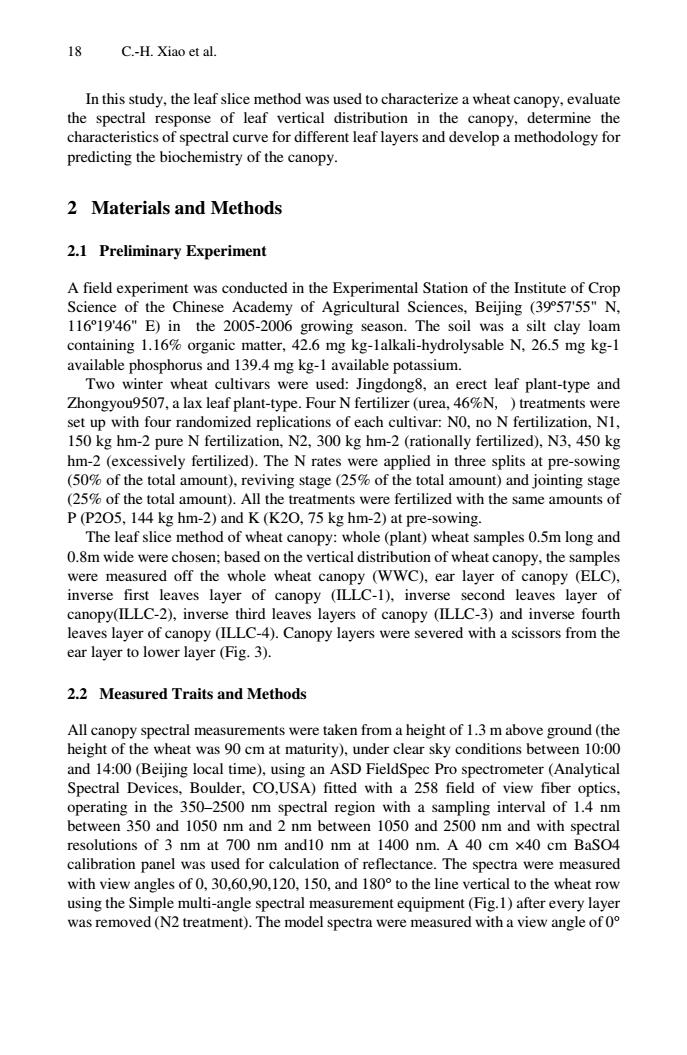正在加载图片...

18 C.-H.Xiao et al In this study,the leaf slice method was used to characterize a wheat canopy,evaluate the spectral response of leaf vertical distribution in the canopy,determine the characteristics of spectral curve for different leaf layers and develop a methodology for predicting the biochemistry of the canopy. 2 Materials and Methods 2.1 Preliminary Experiment A field experiment was conducted in the Experimental Station of the Institute of Crop Science of the Chinese Academy of Agricultural Sciences,Beijing (3957'55"N. 11619'46"E)in the 2005-2006 growing season.The soil was a silt clay loam containing 1.16%organic matter,42.6 mg kg-lalkali-hydrolysable N.26.5 mg kg-1 available ph rus and 139.4 mg kg-1 a rail able pota Two winte at cultivars were used:Jingdong8,an erect leaf plant-type and Zhongyou9507,a lax leaf plant-type.Four N fertilizer (urea,46%N,)treatments were set up with four randomized replications of each cultivar:NO,no N fertilization,N1. 150 kg hm-2 pure N fertilization,N2,300 kg hm-2(rationally fertilized).N3,450 kg hm-2 (excessively fertilized).The N rates were applied in three splits at pre-sowing (50%of the total amount).reviving stage(25%of the total amount)and jointing stag (25%of the total an )All the tr tilized with the same PP205 144kghm-2) K (K20,75 kg h m-2)at pre-sowing The leaf slice method of wheat canopy:whole (plant)wheat samples 0.5m long and 0.8m wide were chosen;based on the vertical distribution of wheat canopy,the samples were measured off the whole wheat canopy (WWC).ear layer of canopy (ELC). inverse first leaves layer of canopy (ILLC-1).inverse second leaves layer of canopy(ILLC-2),inverse third leaves layers of canopy (ILLC-3)and inverse fourth leave s layer of canopy (ILLC-4).Canopy layers were s vered with a sciss ors from the ear layert lowe r layer (Fig.3). 2.2 Measured Traits and Methods All canopy spectral measurements were taken from a height of 1.3 m above ground (the height of the wheat was 90 cm at maturity),under clear sky conditions between 10:00 and 14:00(Beijing local time),usir 258ie0e r(Analytical Spectral Devic r.CO.USA optic operating in spectral region with a sampling interval of 14m between 350 and 1050 nm and 2 nm between 1050 and 2500 nm and with spectral resolutions of 3 nm at 700 nm and1o nm at 1400 nm.A 40 cm x40 cm BaSo4 calibration panel was used for calculation of reflectance.The spectra were measured with view angles of 0.30.60.90.120.150.and 180 to the line vertical to the wheat row using the Sim ple multi-angle sp ctral measurement e quipment(Fig.1)after eve was removed(N2 treatment).The model spectra were measured vith a view angle of 18 C.-H. Xiao et al. In this study, the leaf slice method was used to characterize a wheat canopy, evaluate the spectral response of leaf vertical distribution in the canopy, determine the characteristics of spectral curve for different leaf layers and develop a methodology for predicting the biochemistry of the canopy. 2 Materials and Methods 2.1 Preliminary Experiment A field experiment was conducted in the Experimental Station of the Institute of Crop Science of the Chinese Academy of Agricultural Sciences, Beijing (39º57'55" N, 116º19'46" E) in the 2005-2006 growing season. The soil was a silt clay loam containing 1.16% organic matter, 42.6 mg kg-1alkali-hydrolysable N, 26.5 mg kg-1 available phosphorus and 139.4 mg kg-1 available potassium. Two winter wheat cultivars were used: Jingdong8, an erect leaf plant-type and Zhongyou9507, a lax leaf plant-type. Four N fertilizer (urea, 46%N,) treatments were set up with four randomized replications of each cultivar: N0, no N fertilization, N1, 150 kg hm-2 pure N fertilization, N2, 300 kg hm-2 (rationally fertilized), N3, 450 kg hm-2 (excessively fertilized). The N rates were applied in three splits at pre-sowing (50% of the total amount), reviving stage (25% of the total amount) and jointing stage (25% of the total amount). All the treatments were fertilized with the same amounts of P (P2O5, 144 kg hm-2) and K (K2O, 75 kg hm-2) at pre-sowing. The leaf slice method of wheat canopy: whole (plant) wheat samples 0.5m long and 0.8m wide were chosen; based on the vertical distribution of wheat canopy, the samples were measured off the whole wheat canopy (WWC), ear layer of canopy (ELC), inverse first leaves layer of canopy (ILLC-1), inverse second leaves layer of canopy(ILLC-2), inverse third leaves layers of canopy (ILLC-3) and inverse fourth leaves layer of canopy (ILLC-4). Canopy layers were severed with a scissors from the ear layer to lower layer (Fig. 3). 2.2 Measured Traits and Methods All canopy spectral measurements were taken from a height of 1.3 m above ground (the height of the wheat was 90 cm at maturity), under clear sky conditions between 10:00 and 14:00 (Beijing local time), using an ASD FieldSpec Pro spectrometer (Analytical Spectral Devices, Boulder, CO,USA) fitted with a 258 field of view fiber optics, operating in the 350–2500 nm spectral region with a sampling interval of 1.4 nm between 350 and 1050 nm and 2 nm between 1050 and 2500 nm and with spectral resolutions of 3 nm at 700 nm and10 nm at 1400 nm. A 40 cm ×40 cm BaSO4 calibration panel was used for calculation of reflectance. The spectra were measured with view angles of 0, 30,60,90,120, 150, and 180° to the line vertical to the wheat row using the Simple multi-angle spectral measurement equipment (Fig.1) after every layer was removed (N2 treatment). The model spectra were measured with a view angle of 0°